Introduction
A digital presence and platform are necessary to reach customers in this age. Most businesses have adapted to this situation—digitizing one’s business functions to create an environment of information exchange. Managing your digital platform also includes monitoring it to ensure the sustainable and efficient use of the available resources. Digital Experience Monitoring (DEM) is ideal for managing performance channels and technological accessibility from the user’s perspective.
The basics of DEM
Digital experience monitoring leverages tools that consist of integrated technology solutions for efficient end-user experience monitoring. The goal is to analyze, optimize and manage UX to deliver the best customer journey. DEM enables business owners to employ proper user monitoring to identify issues and roadblocks to improve the exchange processes.
It is also a comprehensive process by which it is possible to take stock of an organization’s already available applications and services to gauge their efficacy. Digital Experience Management helps uncover critical data across digital environments and gives IT teams the means necessary to meet both employee and customer experience expectations.
The importance of Digital Experience Monitoring
Pre-Digital Experience Monitoring, employees were forced to either fix the problems they faced themselves or raise IT support tickets, which took hours to gather basic information, locate the issue and finally help them troubleshoot it. This procedure included a cumbersome questioning and investigation line and didn’t always yield desired results.
A NetMotion survey from September 2020 found that 1 in 3 companies are already using DEM tools.
This approach is unsuited to the modern digital environment since this current workforce uses cloud applications and embraces the bring-your-own-device BYOD culture. Using DME can help organizations track the different factors contributing to the user experience journey like memory usage, hardware usage, software performance, CPU performance, and the like. The IT teams use the data from these metrics to solve and predict problems without informing the user.
This approach flags and takes precautions against problems that did, and could occur, to ensure good employee and customer experiences. It marks a paradigmatic shift in the core IT strategy and comes to include the following:
- End-user Experience Management, including EUX health scoring, engagement, and segmenting of personas.
- Digital Workplace Planning provides VDI migration projects and deploying cloud-based services.
- IT asset optimization through resource usage, software rationalization and license management.
- Service Desk Operation providing proactive support, AIOps and automation.
The benefits of Digital Experience Monitoring
To update and optimize the digital platform content and enable smooth communication, and improve real-life experiences, DEM solutions can be the most effective. Enhancing the performance of an organization with the help of a user experience monitor reaps several benefits for every stakeholder involved. Some of the core benefits are listed here:
User experience monitoring
End-users and customers don’t have access to knowledge of the company’s back-end issues. Hence, they expect the best experience while interacting with the different elements of the UI. Continuously monitoring digital experience across delivery channels in multiple locations may improve the KPIs and overall customer experience.
Generation of useful data
DEM leads to the generation of extensive metrics which help calculate end-to-end network, device, and app KPIs. This includes machine-to-machine, streaming, and specifically defined user journey interactions customized after your application. Analytics and insights powered by AI, which is developed here, can also translate to business successes.
Improved IT visibility
The metrics generated through the monitoring process helps admins to understand employee experiences in-depth. It further helps to determine how productivity can be improved by improving the digital infrastructure by doing things like VDI right-sizing, hardware refreshes, automated fixes, VDI planning and migration, software rationalization, and need-based procurement.
Productivity of employees
When employees deal with fewer technical roadblocks, they perform better and feel happier. When issues are predicted and addressed before they even become full-fledged problems, digital experience for employees becomes that much better. Happier employees also make for satisfied employers: it’s good for everyday productivity, retention, and recruitment.
Technical innovation and growth
Better DEM makes for a competitive advantage for the organizations employing them. Technological innovation and new digital strategies drive successful business outcomes. To look beyond the business’s current capabilities is now considered a good practice. Understanding user needs and employee requirements can place the organization ahead of any guesswork before taking initiatives.
The market forecast for DEM shows much promise
Return on investments and savings
Because of the results of DEM being asset optimization, license management, and service desk improvements, the ROI can count up to thousands, or even millions depending on the size of the enterprise. Predictive analysis, deep data, and expanded visibility have much value, and it is high time that this is recognized.
Objective data
While subjective, qualitative data plays a huge role in determining end-user requirements and improving user experience, the need for objective information is unparalleled. Digital experience monitoring solutions can help with the collection of data like this. It can offer the following:
o Essential data for trends and behavior analysis of end-users
o Customization and personalization
o Deeper insights arrived at via neural network algorithms
o Control center for content management
o Disabling redundant methods and techniques
o Management of omnichannel customer experiences
o Timely alerts as a result of real-time monitoring
Tools used in Digital Experience Monitoring
DEM tools are used to capture problems automatically. They generate insights on page-loading issues, network requests, and the impact of third-party APIs and content services on users.
These tools increase the UX of enterprise cloud, mobile applications, and SaaS platforms. Commonly used DEM tools are AppDynamics, Catchpoint, Dynatrace, Nexthink, Rigor, and SolarWinds Pingdom.
User experience monitoring offers continuous application baselining, quick performance notifications, synthetic transaction monitoring (STM), accurate user monitoring (RUM), and business transaction tracking.
Conclusion
The market for digital experience monitoring solutions has been increasing manifold. Especially with remote working practices, and the need for network communication, DEM technologies are leveraged to enable proactive monitoring and increase the capacity to forecast and secure. These solutions help the organization build more robust and meaningful connections with their employees, customers, and clients.
Nowadays, the prerequisite for any business to get user attention is to ensure that their applications are active and responsive to requests. Users only consider what is visible to them and what they can interact with on the webpage. Therefore, DEM tools have drastically simplified how companies monitor how target audiences interact with their service websites.







